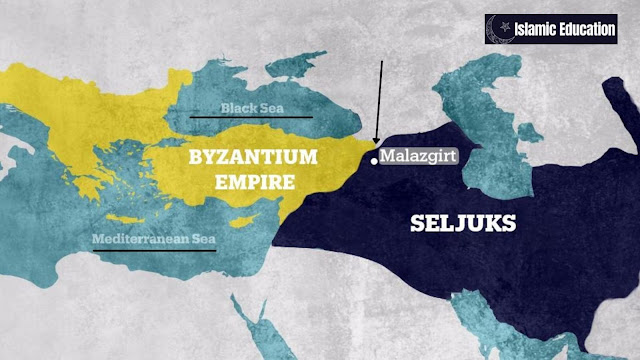On August 26, 1071 AD, two of the
great powers of the time brought their armies to determine the fate of Anatolian
and Middle East lands. These armies were led by Romanus IV Diogenes
(Greek-led Byzantine emperor) and Sultan Alp Arsalan (Turk Seljuk Sultan
of Oguz also called Ghuzz Turk tribe).
Battle of Malazgirt & Battle of
Manzikert
Both the names; Battle of Malazgirt
OR battle of Manzikert are the same. European and associated historians write
it ‘battle of Manzikert’. Whereas, Turk and associated historians write it
“battle of Malazgirt”. Malazgirt is a little town along with the southern
branch of upper Euphrates River (currently situated in Eastern parts of
Turkey), where this battle, which significantly altered history, was fought
between two different powers.
The battle of Malazgirt changed the
geographic influence of two of the great rival superpowers. One was Byzantine
Empire which controlled Constantinople (Currently Istanbul) and the other was
Mongol Empire which had control over Eurasia. But, after the battle of
Malazgirt in 1071, a third power evolved to counter two of the great empires of
that time.
According to one of the Turkish
historians on the subject of the ‘Seljuks’, Professor Mukrimin H. Yinanc, The
Battle of Malazgirt was one of crucial turning points in changing the dynamics
of world history and civilization. Professor Yinanc wrote this in one of his
books, which was published in 2013 “The history of Turkey, The age of the
Seljuks”.
The battle of Malazgirt – A gateway to
Anatolia
In the battle of Malazgirt, Seljuk (also
written as Seljuq) in the leadership of Sultan Alp Arslan defeated arrogant
Romanus IV Diogenes (Byzantine emperor) and formed an individual state which
they called an Anatolian branch of Seljuks. The great Seljuk were from the Oguz
tribe and were originally based in (current) Iran. Anatolian branch of Seljuks later expanded and
conquered many territories by winning off and on the fields of eastern plans of
Anatolia along with its western shores of the Black and Mediterranean Sea.
Historians wrote that a Muslim
Kurdish dynasty, Marwanids, helped Sultan Alp Arsalan and provided him 10,000
volunteer troops for Jihad against Emperor Romanus. This was also known as the Kurdish-Turkish
alliance against the giant arrogant emperor
The battle was fought at Malazgirt
and it was not coincidental. If we see the current location of district
Malazgirt, we will find that in eastern province of Turkey “Mus” is close to Ahlat.
The town at that time was a strategic place located in the northwest of the
“Lake Van” and it was in control of the commanders of Sultan Alp Arsalan for
many years. Defeating these commanders would have been defeating Sultan Alp
Arsalan for Diogenes and his generals.
The Constantinople administration
thought to destroy Ahlat before getting complete control of Anatolia. So, they
marched with their luxurious convoy which was twice in number than the army in
command of Sultan Alp Arsalan as they were having a company of French, Germans,
Scandinavians, and Norman mercenaries. Their purpose was to destroy Turkish
military establishment in Ahlat.
On the other hand, Seljuk Sultan, who
returned from Damascus leaving his campaign of Syria to face an inevitable
force along with his commanders in Ahlat. His grand vizier, one of great
commanders in history, Nizam al-Mulk and his son Malik Shah I were with him while
they were marching towards Ahlat.
Both forces then met at Malazgirt,
just outside of Ahlat to make sure a fight must take place out of the civil
population.
According to historians, Sultan Alp
Arsalan had put himself in white clothes which suggested the possibility of his
death during the battle. He made a speech to high-up the morale of companions
and commanders. Before the battle commenced, he announced to nominate his son,
Malik Shah I, as his heir and next Sultan to prevent political chaos in Seljuk
Sultanate.
He also said that:
Oh, my soldiers! If I became a martyr, this white cloth should be my shroud
At the end of the battle, it was all against the
expectations of any of the leaders of the battleground. Turks got a decisive
victory and captured so many Romans including Greek-led Byzantine emperor,
Romanus IV Diogenes.
According to Yinanc, battle of
Malazgirt synthesized a significant cultural as well as political bond between
two civilized communities i.e. Seljuk-led Muslims (Turkmens) and then Christian-majority
population of Anatolia. Which led to the emergence of a great nation in the
heart of the ancient peninsula called Turkmen nation.
Yinanc also revealed that:
The battle also signifies the most important starting point of the Turkmen march and conquest across the Balkan Peninsula, Hungary, Syria, Egypt, Iraq, the whole of North Africa and the Black Sea Basin, establishing the world’s greatest and the most continuous empire [the Ottoman Empire] after the Roman Empire.
According to historians, the Byzantium, as well as Mongol
Empires, had uncountable victories and both of these two empires were
conquering major parts of the respective hemispheres of the globe. Byzantium
defeated then one of powerful Persian-led dynasties in central Asia and Iran
‘Sasanids’. They didn’t’ stop their invades, they also succeded against Muslim
Arabs and North African regions as well. But, just in a blink of an eye
(approximately 10 years 1071-1081) the conquest of centuries vanished before
Turks led by Sultan Alp Arsalan and later his successors across Anatolian coasts.
The launch of the Crusades
The battle of Malazgirt, also known as a battle between
East Muslim-majority and West Christian-majority changed the geopolitical
situation of the region. After the historic defeat at the hand of the Seljuk
sultan, Sultan Alp Arsalan, the then European States (Christian-majority) allied
to get revenge from Turks. The alliance launched Crusades n Muslim majority
areas in 1095 that was after around 24 years of the battle of Malazgirt.
They continued disastrous crusades for more than two
centuries and devastated the Muslim majority areas in Anatolia.
But, Seljuks didn’t stop countering, they answered
crusades by conquering more lands and forts marching inches towards Constantinople
(Currently Istanbul). That was the capital city of the Eastern Great Roman
Empire and European landscape.
The role of Ottomans during Crusades
To
counter crusades, The great Seljuk brought Ottomans to settle at the borderlines
of Constantinople. Ottomans were great fighters and hard to beat Turk tribes.
One of their tribes were ‘Kai’ who later formed ‘Ottoman Empire’ and influenced
half of the world for around 7 centuries.
Battle of Malazgirt – A victory for
Muslims
Before the battle of Malazgirt, the Abbasid Caliph in
Baghdad sent a prayer for Sultan Alp Arslan and the victory of his mighty army.
The prayer was sent in mosques of the Islamic world. Historians have also mentioned
this prayer in their books as well and it was:
Oh, Allah! Raise the flags of Islam and do not leave your mujahidin, who do not mind sacrificing their lives to follow your rule, alone. Make Alp Arslan victorious over his enemies and support his soldiers with your angels.
The victory was celebrated across Muslim world including
Baghdad, the capital city of the Abbasid dynasty.
Turan, one of the nice and unbiased historians, wrote in
his book, The History of Seljuks and The Turkish-Islamic Civilisation.
The whole city of Baghdad was decorated as unseen for decades, building ‘triumphal arches'. Music was played as people hit the streets of the city to celebrate the victory
As a result, the magnificent victory, which came into existence with the imprisonment of a Byzantium emperor as a first in history, has been celebrated by its significance.
The historians have regarded the
victory as a gateway to Anatolia for Muslim migrants, shepherds and Viking
tribes (Khanabadosh). Some historians have also mentioned the significance of
the victory of battle of Malazgirt by giving the similarity of it with the
great battles of Yarmouk and Al-Qadsiyyah. Both of these battles have been
remembered as a gateway of Muslims in the lands of Asia and Mediterranean lands
respectively.









